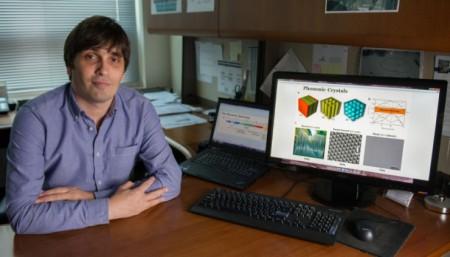 Martin Maldovan, of the Georgia Institute of Technology, has published a review article on
Martin Maldovan, of the Georgia Institute of Technology, has published a review article on phononics in Nature. (Credit: Rob Felt / Georgia Tech)
The emerging field of phononics opens a number of exciting possibilities in the energy field. In a recent review article in Nature, Martin Maldovan of the Georgia Institute of Technology explains how new ideas and devices that make use of phononic properties can be used to control both sound and heat.
In the article he blends eight different subjects in the field of phononics, describing advances in sonic and thermal diodes, optomechanical crystals, acoustic and thermal cloaking, hypersonic phononic crystals, thermoelectrics and thermocrystals.
The future possibilities for phonons might olve the biggest challenges in energy consumption and buildings today. Understanding and controlling the phononic properties of materials could lead to novel technologies to thermally insulate buildings, reduce environmental noise, transform waste heat into electricity and develop earthquake protection, all by developing new materials to manipulate sound and heat. These ideas are all possible in theory, but to make them a reality, phononics will have to inspire the same level of scientific innovation as electronics, and today that’s not the case.
“People know about electrons because of computers, and electromagnetic waves because of cell phones, but not so much about phonons,” said Martin Maldovan, a research scientist in the School of Chemical and Biomolecular Engineering at the Georgia Institute of Technology.
The phonon is the physical particle representing mechanical vibration and is responsible for the transmission of everyday sound and heat. Often referred to as a quasiparticle, it represents an excited state in the quantum mechanical quantization of the modes of vibrations of elastic structures of interacting particles. Phonons play a major role in many of the physical properties of condensed matter, such as thermal conductivity and electrical conductivity. The study of phonons is an important part of condensed matter physics.The hottest fields in phononics, Maldovan said, is the development of acoustic and thermal metamaterials. These materials are capable of cloaking sound waves and thermal flows. The phononics approach to cloaking is based on electromagnetic cloaking materials that are already in use for light.
Maldovan, formerly a research scientist at the Massachusetts Institute of Technology, also conducts phononics research of his own. This past summer, Maldovan published an article in the journal Physical Review Letters, describing an invention for controlling the conduction of heat through solid objects.
Known as thermocrystals, this new area of phononics research seeks to manage heat waves in a similar manner as sound and light waves, by channeling the flow of heat at certain frequencies. The technology could lead to devices that convert heat into energy, or the thermal equivalent of diodes, which could help data centers solve the problem of massive heat generated by their servers.
“The field of Phononics is relatively new, and when you have something new you don’t know what you will find,” Maldovan said. “You’re always thinking ‘what can I do with that?’”
Martin Maldovan (2013). Sound and heat revolutions in phononics Nature, 503, 209-217 DOI: 10.1038/nature12608
